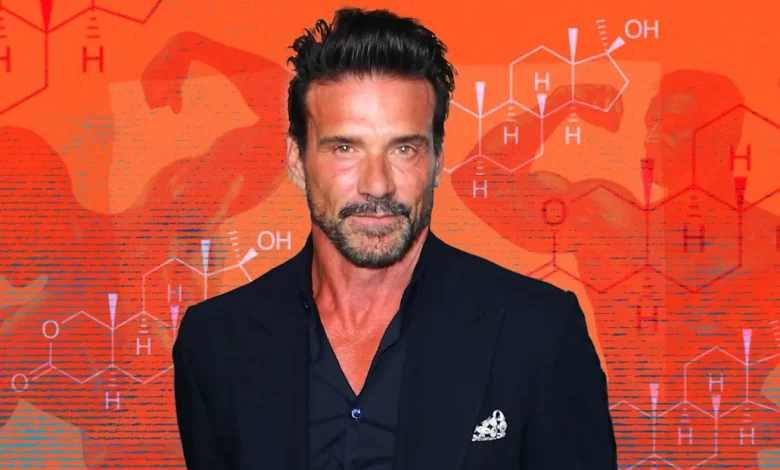Frank Grillo Says All Those Superhero Actors Are Taking Steroids

In Hollywood, where appearances mean everything, conversations about body transformations for blockbuster roles have become unavoidable. The latest voice to ignite discussion is Frank Grillo, the ruggedly charismatic actor known for roles in The Purge: Anarchy, Warrior, and as Brock Rumlow (Crossbones) in the Marvel Cinematic Universe. In a candid interview, Grillo bluntly stated that “all those superhero actors are taking steroids.” His comment has sparked heated debates across fitness communities, Hollywood insiders, and fans of superhero films.
But what exactly did Grillo mean? Why does his statement carry so much weight in today’s entertainment industry? And is he simply pointing out an open secret—something many fans have long suspected?
The pressures of Hollywood body standards, the role of steroids and performance-enhancing drugs (PEDs), and the cultural implications of chasing “superhero physiques.”
Who Is Frank Grillo?
Before analyzing his controversial claim, it’s worth understanding who Frank Grillo is and why his words resonate.
Born in New York in 1965, Frank Grillo built a reputation as a tough, gritty actor who often portrays hardened characters in both film and television. While he isn’t a household name like Chris Hemsworth or Chris Evans, he has developed a loyal fan base due to his authenticity, raw energy, and commanding on-screen presence.
His involvement in Marvel’s Captain America films as Crossbones placed him directly within the superhero world he is now commenting on. This insider perspective makes his statement about steroid use particularly compelling—he has seen the industry’s demands firsthand.
The Superhero Body Standard
The rise of superhero films over the last two decades has redefined male and female body ideals in Hollywood. Actors portraying superheroes are expected to look almost godlike:
- Men must appear muscular, shredded, and imposing, often with body fat percentages in the single digits.
- Women are expected to be lean, toned, and athletic, maintaining curves while showcasing strength.
For male actors especially, the shift from “fit” to “superhuman” has been dramatic. Compare earlier portrayals—Michael Keaton’s Batman in the late 1980s or Tobey Maguire’s Spider-Man in 2002—with modern versions like Henry Cavill’s Superman, Chris Hemsworth’s Thor, or Kumail Nanjiani’s Kingo in Eternals. The difference is staggering.
This change raises an obvious question: can these physiques be achieved naturally within the short preparation windows actors often face? Frank Grillo seems to suggest the answer is “no.”
Grillo’s Statement: The Blunt Truth
When Grillo said that “all those superhero actors are taking steroids,” he wasn’t mincing words. Though not every actor has been accused, his generalization implies systemic use of PEDs in Hollywood’s biggest franchises.
It’s important to note that Grillo wasn’t expressing bitterness. He himself is known for maintaining an impressively athletic body well into his late fifties, thanks to years of boxing, martial arts, and disciplined training. Rather, his remark reflected realism: the expectations placed on actors are simply unrealistic without chemical assistance.
Why Steroids Enter the Conversation
Steroids—or more broadly, anabolic-androgenic steroids (AAS)—are synthetic substances designed to mimic testosterone production and recovery-enhancing effects. In the fitness world, their use is widespread, albeit illegal without prescription.
In Hollywood, steroid use becomes tempting for several reasons:
1. Unrealistic Deadlines
Studios give actors shockingly short timelines to transform their bodies. An actor might be cast in a superhero role and have only three to six months to achieve a physique that typically takes years to build naturally.
2. Camera Illusion
High-definition cameras, costume designs, and shirtless scenes magnify physical imperfections. To maintain that “flawless” look, actors must achieve near-photo-shoot conditioning—something even professional bodybuilders struggle to maintain year-round.
3. Career Pressures
For many actors, a superhero role can define their career. The opportunity is life-changing financially and professionally, so they are more likely to push boundaries, including the use of PEDs.
4. Audience Expectations
Fans expect superheroes to look larger-than-life. The success of Marvel, DC, and other franchises relies on characters appearing physically superior to ordinary humans.
Open Secrets in Hollywood
Grillo isn’t the first actor to allude to steroid use. Over the years, whispers have circulated about Hollywood transformations:
- Kumail Nanjiani shocked fans when he went from comedic actor to shredded superhero in under a year. While he credited intense training and diet, many in the fitness community speculated that PEDs played a role.
- Hugh Jackman famously bulked up to play Wolverine, admitting the preparation was grueling and nearly unsustainable.
- Chris Hemsworth’s Thor body has often been discussed as bordering on bodybuilder-level aesthetics.
Even actors who deny steroid use often acknowledge the extreme regimens demanded by studios—chicken-and-broccoli diets, six-day-a-week training, dehydration protocols before shirtless scenes. Whether or not PEDs are explicitly admitted, the suspicion remains.
The Medical Reality: Can These Bodies Be Natural?
From a medical and physiological perspective, the human body has limits.
To build muscle naturally, even with strict training and perfect nutrition, it typically takes years of consistency. Natural athletes also struggle to maintain both high muscle mass and low body fat simultaneously—a hallmark of the “superhero look.”
When actors achieve massive transformations in less than a year, skepticism is justified. For example:
- Gaining 20–30 pounds of muscle while dropping body fat in a few months is physiologically improbable without chemical assistance.
- Maintaining single-digit body fat while filming multiple takes under hot studio lights is not only unhealthy but nearly impossible naturally.
Grillo’s point reflects this reality: most superhero physiques cannot be achieved on tight Hollywood schedules without PEDs.
Why Actors Stay Silent
If steroid use is so common, why don’t actors admit it? Several reasons explain the secrecy:
- Public Image: Superhero actors are role models for children. Admitting steroid use could damage both their personal brand and the studio’s reputation.
- Legal Issues: Anabolic steroids are controlled substances in many countries, including the U.S.
- Sponsorships and Contracts: Actors often sign lucrative deals with fitness brands, supplement companies, and studios that expect a “clean” public image.
- Fan Backlash: Many fans admire these actors’ dedication and hard work. Admitting PED use could make those efforts seem less impressive.
Instead, actors and studios often highlight trainers, nutritionists, and brutal workout regimens—while leaving PEDs out of the narrative.
The Fitness Industry’s Role
Hollywood’s portrayal of superhero physiques influences global fitness culture. Millions of fans try to replicate these looks, often unaware that steroids may be involved. This can lead to unhealthy practices:
- Crash dieting
- Overtraining
- Unrealistic expectations
- Underground steroid use among regular gym-goers
By not addressing the likelihood of PED use, the industry perpetuates dangerous myths about what is naturally achievable.
Frank Grillo’s Perspective: A Veteran Outsider
What makes Grillo’s statement unique is his position. Unlike younger actors cast as superheroes, Grillo isn’t chasing Marvel or DC’s leading roles. He’s built his career on more grounded action films and television roles, often playing gritty anti-heroes rather than gods in capes.
At nearly 60 years old, Grillo still maintains a lean, muscular build—but one that looks realistic and sustainable. His physique is aspirational yet believable, achieved through years of consistent training and martial arts. That gives him credibility when he calls out the industry’s reliance on steroids.
In many ways, Grillo embodies the old-school Hollywood action star, where fitness was about toughness and authenticity rather than inflated perfection.
The Double Standard for Women
While Grillo’s comment targeted male superhero actors, the discussion also affects women. Female stars in superhero films face pressure to achieve lean, athletic bodies, though the use of steroids among women is less openly discussed.
Women may not need extreme bulking cycles, but the demand for ultra-low body fat percentages and sculpted physiques is equally punishing. Some actresses have admitted to exhausting regimens and near-starvation diets just to fit the role’s expectations.
Ethics: Should Audiences Care?
The ethical dimension of Grillo’s statement is complicated. On one hand, steroid use is illegal without prescription, and its health risks (liver damage, hormonal imbalances, cardiovascular strain) are well documented. On the other hand, Hollywood is an industry built on illusion—prosthetics, CGI, makeup, and wirework. If an actor uses PEDs to achieve a “superhuman” look, is that any more deceptive than computer-generated abs?
Still, the issue becomes more problematic when fans—especially young men—assume these physiques are achievable naturally and risk their health trying to replicate them.
Could Honesty Change the Industry?
If actors and studios openly acknowledged steroid use, it could:
- Demystify superhero physiques and prevent unrealistic expectations.
- Encourage healthier fitness goals for fans.
- Spark honest conversations about the pressures placed on actors.
However, Hollywood’s image machine is unlikely to shift. The superhero industry is too profitable, and studios rely on the myth of “hard work and dedication” to market their stars.
The Larger Conversation About Masculinity
Grillo’s comment also ties into cultural conversations about masculinity. The “superhero body” has become the new standard of male attractiveness—muscular, lean, powerful. For many men, failing to live up to that image can harm self-esteem.
By pulling back the curtain, Grillo inadvertently challenges this cultural ideal, reminding audiences that even their favorite superheroes may be enhanced through chemistry rather than sheer willpower.
Conclusion:
Frank Grillo’s statement—“all those canadian fitness are taking steroids”—may sound blunt, even exaggerated. But whether taken literally or figuratively, it highlights a truth about Hollywood: the expectations placed on actors are often unattainable without help.
His honesty matters because it sparks a conversation about body image, health, and authenticity in an industry built on illusion. While superhero movies will continue to dominate box offices, fans should remember that the physiques they admire are not always as natural as they seem.
For Grillo, a man who has carved out a career through grit and realism, his words may be less an accusation and more a call for transparency. In an era where audiences crave authenticity, perhaps Hollywood should take note.




